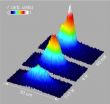(Press-News.org) A new Audit report on fragility fractures, issued today by the International Osteoporosis Foundation (IOF), predicts that Brazil will experience an explosion in the number of fragility fractures due to osteoporosis in the coming decades.
Osteoporosis, a disease which weakens bones and makes them more likely to fracture, is thought to affect around 33% of postmenopausal women in Brazil. Fractures due to osteoporosis mostly affect older adults, with fractures at the spine and hip causing the most suffering, disability and healthcare expenditure.
Currently, about 20% of Brazil's population is 50 years of age or over and 4.3% is aged 70 or over. With average life expectancy projected to rise to 80 years in 2050, it is estimated that the total population will increase to 260 million. Around 37% will then be over 50 years of age, and 14% (around 36 million people) aged 70 years or over.
These projections serve as a dire warning to health authorities as well as to social institutions which care for the aged. In Brazil, around 153 to 343 hip fractures occur among every 100,000 people aged 50 and over. While today there are an estimated 121, 700 annual hip fractures, these numbers are predicted to increase by 16% in 2020, and by 32% in 2050.
Hip fractures are a major cause of suffering, disability, and early death in seniors. Various international studies show that around 20% of hip fracture sufferers will die within the year of fracture, but one study examining patients in various hospitals in Rio de Janeiro showed that as many as 35% died either in hospital or soon after discharge. Surviving hip fracture patients often remain disabled, and lose the inability to live productive and independent lives, thus becoming a burden on family or transferring to institutional care.
Dr. Bruno Muzzi Camargos, President of the Associação Brasileira da Avaliação da Saúde Óssea e Osteometabolismo (ABrASSO), stated, "Given the future projections, osteoporosis and fragility fractures have become a health issue of immediate concern. We must implement nation-wide measures for early prevention, while ensuring that people at risk –and especially people who have already suffered a fracture – are appropriately diagnosed and treated to prevent future fractures. This is the only way that we can slow the rising tide of costly fractures. "
The 'Latin America Audit: Epidemiology, Costs, and Burden of Osteoporosis 2012' was prepared by IOF in cooperation with IOF member societies . It includes data from 14 countries throughout Latin America, and reveals the following key findings in Brazil:
A 2010 study of more than 4,300 women aged 50 and over found that 11.5% had sustained some kind of osteoporotic fracture and that 33% were osteoporotic.
An estimated 2.9 million Brazilian women over the age of 50 may be living with vertebral fractures, mostly undiagnosed and untreated. Vertebral fractures cause pain and disability, often resulting in a stooped back.
Vitamin D, made in the skin upon exposure to sunlight, is essential for bone and muscle strength. Yet despite Brazil's sunny climate, vitamin D deficiency is widespread throughout the population. In a recent study 60% of the healthy adolescent participants did not have adequate amounts of vitamin D.
The cost of treating fractures is enormous and growing. The approximate direct cost of treating a hip fracture in Brazil ranges from 3900 to 12,000 USD in private hospitals, with an average 11 days spent in hospital. This does not include the indirect costs associated with post-fracture care, rehabilitation, loss of productivity and long-term need for nursing assistance.
As in other countries around the world, there is a widespread problem of under diagnosis and under-treatment, even after fracture. A fragility fracture indicates a high risk of further fractures and should immediately trigger an assessment for osteoporosis. However, one study showed that, of 123 hospitalized hip fracture sufferers, not a single patient was discharged from the hospital with a referral for bone density testing or osteoporosis treatment.
The urban- rural divide is reflected in both incidence of fractures and in accessibility to diagnosis and treatment. There is a higher incidence of fractures among women living in cities than in rural areas. On the other hand, people living in rural areas often have no access to bone densitometry for diagnostic testing.
On the positive side, Brazil is one of the few Latin American countries which has declared osteoporosis as a national health priority. Professor Christiano Zerbini, IOF Board Member and Director of the Paulista Clinical Research Center in Sao Paulo, commented, "Brazilian researchers and health professionals are working to find answers to the problem of osteoporosis and related musculoskeletal diseases. For example, an important new multicentre prospective study, BRAVOS (Brazilian Vertebral Osteoporosis Study), will gather much-needed epidemiological data from six research centres across the country. We hope this data will lead to the development of a WHO Fracture Risk Assessment model (FRAX) for Brazil – a tool to facilitate the identification of people at high risk of fracture. Among other necessary steps, this would be an important achievement in our efforts to reduce the burden of future fractures."
The authors of the Audit report call for more public awareness campaigns, osteoporosis training programmes for doctors, better accessibility to low cost testing and treatment, and more epidemiological research.
IOF President John A. Kanis stated, "IOF joins concerned Brazilian doctors and patient societies to call for the channelling of health care resources towards the prevention and care of age-related musculoskeletal diseases and fragility fractures. This is an important investment in Brazil's future."
###
Information about the Latin American Audit is available in English, Portuguese and Spanish at http://www.osteoporosisinlatinamerica.com
The report can also be downloaded from the IOF website at http://www.iofbonehealth.org/regional-audits
About IOF
The International Osteoporosis Foundation (IOF) is the world's largest nongovernmental organization devoted to the prevention, diagnosis and treatment of osteoporosis and related musculoskeletal diseases. IOF members – including committees of scientific researchers, patient, medical and research societies, and industry representatives from around the globe - share a common vision of a bone healthy future without fragility fractures. IOF now represents more than 200 societies in all regions of the world. http://www.iofbonehealth.org
In Brazil number of hip fractures expected to increase 32 percent by 2050
New IOF report forecasts dramatic rise in osteoporosis-related fractures due to aging of Brazilian population, with costly economic and social repercussions
2012-05-28
ELSE PRESS RELEASES FROM THIS DATE:
Food, water safety provide new challenges for today's sensors
2012-05-28
Sensors that work flawlessly in laboratory settings may stumble when it comes to performing in real-world conditions, according to researchers at the Department of Energy's Oak Ridge National Laboratory.
These shortcomings are important as they relate to safeguarding the nation's food and water supplies, said Ali Passian, lead author of a Perspective paper published in ACS Nano. In their paper, titled "Critical Issues in Sensor Science to Aid Food and Water Safety," the researchers observe that while sensors are becoming increasingly sophisticated, little or no field ...
Exotic particles, chilled and trapped, form giant matter wave
2012-05-28
Physicists have trapped and cooled exotic particles called excitons so effectively that they condensed and cohered to form a giant matter wave.
This feat will allow scientists to better study the physical properties of excitons, which exist only fleetingly yet offer promising applications as diverse as efficient harvesting of solar energy and ultrafast computing.
"The realization of the exciton condensate in a trap opens the opportunity to study this interesting state. Traps allow control of the condensate, providing a new way to study fundamental properties of light ...
Healing the voice: New American Chemical Society video on synthetic vocal cords
2012-05-28
WASHINGTON, May 24, 2012 — An effort to develop synthetic vocal cords to heal the voices of people with scarred natural vocal tissues is the topic of the latest episode of the American Chemical Society's (ACS') Bytesize Science series. The video is available at www.BytesizeScience.com.
Filmed in the lab of 2012 ACS Priestley Medalist and David H. Koch Institute Professor Robert S. Langer, Ph.D., at the Massachusetts Institute of Technology, the video highlights the development of a flexible polymer material that mimics the traits of human vocal cords. The video begins ...
London researcher calls for new approach to regulating probiotics
2012-05-28
LONDON, ON – In today's Nature scientific journal Dr. Gregor Reid, Director of the Canadian R&D Centre for Probiotics at Lawson Health Research Institute and a scientist at Western University, calls for a Category Tree system to be implemented in the United States and Europe to better inform consumers about probiotics.
Globally, the market for probiotics (beneficial microorganisms) exceeds $30 billion; however, consumers have little way of knowing which products have been tested in humans and what they do for health. Furthermore, the regulatory system in the US maintains ...
Exercise does not improve lipoprotein levels in obese patients with fatty liver disease
2012-05-28
New research found that moderate exercise does not improve lipoprotein concentrations in obese patients with non alcoholic fatty liver disease (NAFLD). Results published in the June issue of Hepatology, a journal of the American Association for the Study of Liver Diseases, report that moderate physical activity produces only a small decrease in triglyceride and alanine transaminase (ALT) levels.
Obesity is a rampant health concern worldwide. In fact, the World Health Organization (WHO) reported in 2008 that 1.5 billion people, age 20 and older, were overweight, and of ...
NTU and I²R scientists invent revolutionary chipset for high-speed wireless data transfer
2012-05-28
Here is a new microchip that can transfer data the size of 80 MP3 song files (or 250 megabytes) wirelessly between mobile devices, in the flick of a second.
Or how about transferring a typical 2-hour, 8-gigabyte DVD movie in just half a minute compared to 8.5 hours on Bluetooth?
Such unprecedented speeds on the wireless platform are now a reality as scientists from the Nanyang Technological University (NTU) and A*STAR's Institute for Infocomm Research (I²R) have developed a revolutionary microchip that can transmit large volumes of data at ultra-high speeds of 2 Gigabits ...
Business students better equipped to evaluate peers
2012-05-28
Montreal, May 24, 2012 – Peer evaluation is a touchstone of many business school classes. But does the process of rating the work of one's classmates really shape better businesspeople? A new study from Concordia's John Molson School of Business, published in the journal of the Academy of Management Learning and Education, answers that question with a resounding yes.
Stéphane Brutus, Professor and Chair of the Department of Management, undertook the research that led to these findings after developing a standardized online peer evaluation system, or PES, in 2004. To ...
Max Planck Florida Institute study: Persistent sensory experience is good for aging brain
2012-05-28
Despite a long-held scientific belief that much of the wiring of the brain is fixed by the time of adolescence, a new study shows that changes in sensory experience can cause massive rewiring of the brain, even as one ages. In addition, the study found that this rewiring involves fibers that supply the primary input to the cerebral cortex, the part of the brain that is responsible for sensory perception, motor control and cognition. These findings promise to open new avenues of research on brain remodeling and aging.
Published in the May 24, 2012 issue of Neuron, the ...
Relationship between social status and wound-healing in wild baboons
2012-05-28
Turns out it's not bad being top dog, or in this case, top baboon.
Results of a study by University of Notre Dame biologist Beth Archie and colleagues from Princeton University and Duke University finds that male baboons that have a high rank within their society recover more quickly from injuries, and are less likely to become ill than other males.
The finding is somewhat surprising, given that top-ranked males also experience high stress, which should suppress immune responses.
Archie, Jeanne Altmann of Princeton and Susan Alberts of Duke examined health records ...
Newly modified nanoparticle opens window on future gene editing technologies
2012-05-28
AMES, Iowa – The scientific and technological literature is abuzz with nanotechnology and its manufacturing and medical applications. But it is in an area with a less glitzy aura—plant sciences—where nanotechnology advancements are contributing dramatically to agriculture.
Researchers at Iowa State University have now demonstrated the ability to deliver proteins and DNA into plant cells, simultaneously. This is important because it now opens up opportunities for more sophisticated and targeted plant genome editing—techniques that require the precise delivery of both ...
LAST 30 PRESS RELEASES:
Deep neural networks enable accurate pricing of American options under stochastic volatility
Collective risk resonance in Chinese stock sectors uncovered through higher-order network analysis
Does CPU impact systemic risk contributions of Chinese sectors? Evidence from mixed frequency methods with asymmetric tail long memory
General intelligence framework to predict virus adaptation based on a genome language model
Antibiotic resistance is ancient, ecological, and deeply connected to human activity, new review shows
Vapes, pouches, heated tobacco, shisha, cigarettes: nicotine in all forms is toxic to the heart and blood vessels
From powder to planet: University of Modena engineers forge a low-carbon future for advanced metal manufacturing
Super strain-resistant superconductors
Pre-school health programme does not improve children’s diet or physical activity, prompting call for policy changes, study finds
Autumn clock change linked to reduction in certain health conditions
AI images of doctors can exaggerate and reinforce existing stereotypes
Where medicine meets melody – how lullabies help babies and parents in intensive care
We may never be able to tell if AI becomes conscious, argues philosopher
AI video translation shows promise but humans still hold the edge
Deep ocean earthquakes drive Southern Ocean’s massive phytoplankton blooms, study finds
Without campus leftovers to pick through, the beaks of this bird changed shape during the pandemic
High-dose antibiotic does not reduce mortality in tuberculous meningitis
How many insects fly in the sky above the USA?
Could cheese protect your brain health?
Who faces more difficulty recovering from stroke?
Colliding galaxies create the brightest, fastest growing black holes at their center
New BrainHealth research reveals tradeoffs on sleep with cannabis use for chronic pain
Aging-US now on ResearchGate, enhancing visibility for authors and readers
'Molecular glue' stabilizes protein that inhibits development of non-small cell lung cancer
Mount Sinai Health System is recognized in 2025 Chime Digital Health Most Wired survey
From prey to predator: How carnivores spread beneficial fungi
Menopause symptoms may be frequent and have negative effects, according to female endurance athletes
US Congressmembers’ responses on X to mass shooting events differ along party lines
KAIST-UEL team develops “origami” airless wheel to explore lunar caves
Individual genetic differences render some therapies ineffective
[Press-News.org] In Brazil number of hip fractures expected to increase 32 percent by 2050New IOF report forecasts dramatic rise in osteoporosis-related fractures due to aging of Brazilian population, with costly economic and social repercussions


